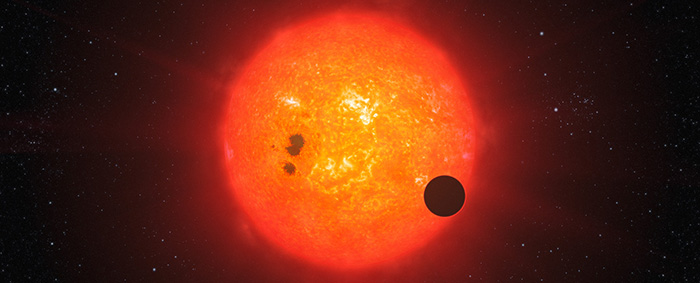Discovering planets orbiting other stars involves indirectly detecting the effects they have on your star. When looking for planets as small as Earth, these effects can be diluted in the “noise” of stellar activity, created by stellar spots or zones high gloss. This activity can even mimic the presence of one or more planets, which in fact do not exist.
A disagreement about the existence of planets around the star HD 41248, in the constellation Pintor, in the southern celestial hemisphere, has now been resolved with the first data obtained by the spectrograph ESPRESSO A study (DOI: 10.1051 / 0004-6361 / 201936389), to be published by the scientific journal Astronomy & Astrophysics and led by João Faria, from the Institute of Astrophysics and Space Science (IA) and Faculty of Sciences of the University of Porto (FCUP), and with the participation of a dozen other AI researchers, concluded that what appeared to be the signal of two orbiting planets is most likely activity of the star itself.
“Our work demonstrates that detecting small planets, even larger than Earth, is not an easy task. The contamination caused by the star itself has to be taken into account and corrected”, comments João Faria. “This will certainly be a necessary step towards the detection of a planet like Earth, and this study is the first advance in the use of ESPRESSO for this purpose.”
The star HD 41248 is about 181 light years from Earth. It is a little smaller and less massive than the Sun and is also older. It was the subject of three scientific articles that disagreed on the existence of two planets orbiting it. The accuracy of the HARPS spectrograph used in these previous studies, an instrument located at the La Silla Observatory, in Chile, was not sufficient to solve the problem with a reasonable number of new observations.
This new article brings together the pre-existing data, obtained in 2003 and 2014 with HARPS, with those obtained now with ESPRESSO, in the VLT. Inaugurated in September 2018, the construction of this instrument had the participation and co-leadership of the IA. The data now obtained represent the debut of ESPRESSO in the search for exoplanets. With unprecedented precision (smaller margin of error) in measuring radial velocities, these new observations make it possible to distinguish signals from planets from those caused by stellar activity.
The Radial Velocity Method detects exoplanets by measuring small variations in the (radial) velocity of the star, due to the movement that the orbits of these planets impart on the star. As an example, the variation in speed that the Earth's motion prints on the Sun is only 10 centimeters per second (about 0,36 km/h). With this method it is possible to determine the minimum mass value of the planet. However, in conjunction with the method of transits, it is possible to determine the real mass.
According to the authors of this study, the dataset cannot be consistently explained by the existence of a planetary system. On the contrary, models of the star's activity better reproduce the observations on their own. These models interpret radial velocity variations as active regions on the star's surface (for example, spots or bright spots, such as those on the Sun) that, as the star completes one rotation every 25 days, now arise from a side of the star, now they hide on the opposite side. These models adjust in such a way to the signal registered in the star's light spectrum that they leave no margin for the previously announced existence of planets.
The precision of ESPRESSO highlights physical processes in stars, some not yet fully understood, which cover up or mimic the signal produced by small planets. According to Nuno Santos, co-author of the article, IA researcher, professor at FCUP, and co-principal investigator of ESPRESSO, “this result shows that, in addition to the incredible ability that ESPRESSO has to search for new planets, the data collected also allows us to obtain unique information about the stars and that give us the possibility of subtracting sources of signals that can mislead our observations.”
“But we still need to better understand how stellar activity can affect the velocity variations we measure,” adds João Faria, “and find better methods to analyze and extract all the information from the data.” In this context, this researcher is developing a computer tool that allows the use of stripes in the spectrum of the star that are less affected by its activity.
“This is the first data analysis of ESPRESSO and it shows that the instrument is producing radial velocities with the expected precision, and that it will be enough to detect Earth-like planets”, says João Faria.
Author Institute of Astrophysics and Space Science
© 2019 – Science in the Regional Press / Ciência Viva



















Comments